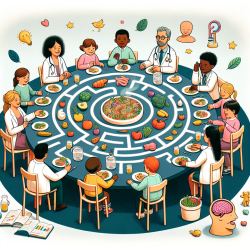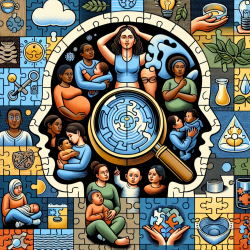Introduction
In the field of speech-language pathology, understanding the coexistence of psychiatric disorders and intellectual disability (ID) in children is crucial for developing effective therapeutic interventions. The study titled The Coexistence of Psychiatric Disorders and Intellectual Disability in Children Aged 3–18 Years in the Barwani District, India offers valuable insights into the prevalence of psychiatric disorders among children with ID. This blog post aims to highlight the key findings of this research and discuss how practitioners can leverage these insights to improve outcomes for children.
Key Findings
The study conducted in the Barwani District of India evaluated 262 children with ID for psychiatric disorders using the ICD-10 criteria. The results revealed a significant prevalence of psychiatric disorders among these children, with behavioral problems being the most common (80.9%). Other disorders identified included epilepsy (23.7%), ADHD (6.5%), autism (4.2%), and anxiety (2.7%). Notably, the prevalence of psychiatric disorders was higher in children with severe intellectual disabilities (IQ ≤ 49) compared to those with mild intellectual disabilities (IQ ≥ 50).
Implications for Practitioners
Practitioners can draw several implications from these findings to enhance their therapeutic approaches:
- Comprehensive Assessment: Given the high prevalence of psychiatric disorders in children with ID, practitioners should conduct comprehensive assessments that include both cognitive and psychiatric evaluations. This approach ensures that coexisting conditions are identified and addressed.
- Tailored Interventions: The study highlights the need for tailored interventions that consider the severity of ID and the specific psychiatric disorders present. For instance, children with severe ID may require more intensive support and specialized interventions to address their unique needs.
- Collaboration with Multidisciplinary Teams: Effective management of coexisting psychiatric disorders in children with ID often requires collaboration with a multidisciplinary team, including psychiatrists, psychologists, and educators. This collaborative approach can lead to more holistic care and better outcomes.
- Focus on Behavioral Interventions: Given the high prevalence of behavioral problems, practitioners should prioritize behavioral interventions that promote positive behaviors and reduce disruptive ones. Techniques such as positive reinforcement and structured routines can be particularly beneficial.
Encouraging Further Research
While the study provides valuable insights, it also underscores the need for further research in this area. Practitioners are encouraged to engage in research initiatives that explore the effectiveness of various therapeutic interventions for children with ID and coexisting psychiatric disorders. By contributing to the body of knowledge, practitioners can help refine therapeutic approaches and improve outcomes for this population.
Conclusion
The coexistence of psychiatric disorders and intellectual disability in children presents unique challenges for practitioners. By leveraging the insights from the Barwani District study, practitioners can enhance their assessment and intervention strategies, ultimately leading to better outcomes for children. To read the original research paper, please follow this link: The Coexistence of Psychiatric Disorders and Intellectual Disability in Children Aged 3–18 Years in the Barwani District, India.










